Apple 4400 User Manual

Chapter 1 |
Getting Started |
Chapter 2 |
Getting Help |
Chapter 3 |
Connecting Equipment and Expanding Your Computer |
Chapter 4 |
Installing and Using Application Programs |
Chapter 5 |
Connecting Your Computer to a Network |
partI


Follow the instructions in this
chapter to set up your computer
and learn the basics.
1 Getting Started
The illustration on the next page shows all the equipment you will need to set up your computer and begin using it. Place your equipment on a sturdy, flat surface near a grounded wall outlet. Before following the setup instructions in this chapter, you may want to read “Arranging Your Office” in Appendix A (in the section on health-related information) for tips on adjusting your work furniture so that you’re comfortable when using the computer.
Plugging in the computer
Before you plug your Macintosh into a wall socket, carefully read all the setup instructions in this chapter. Then, before you connect any other devices to it, follow the instructions on how to plug in your Macintosh. The plug grounds the computer and protects it from electrical damage while you are setting up.
3
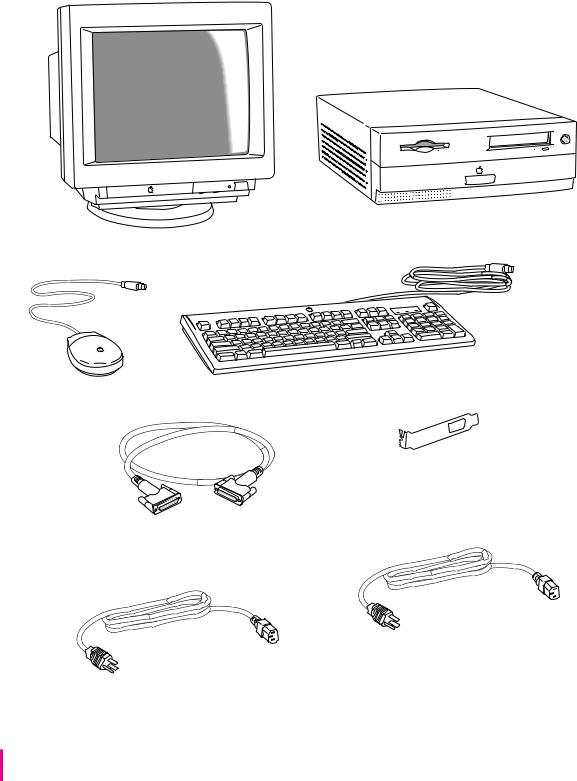
Macintosh computer
(your monitor may look different)
Keyboard cable
(sometimes built into the keyboard as shown here)
Mouse
Communication card access cover
(already installed in your computer if you have an optional communication card installed)
Monitor cable
(sometimes built into the monitor)
Monitor power cord
(sometimes built into the monitor)
Computer power cord
4 Chapter 1

When you are ready to begin, follow these steps:
1Make sure the voltage switch on the back of the computer is set for the kind of voltage system to which you will be connecting.
The voltage switch must be set correctly to avoid damaging your computer. If you don’t know the voltage used in the country you’re in, refer to the table “Voltages for Different Locations” later in this section.
Check to see that the voltage switch on the back of your computer is properly set before you plug it in.
If you need to change the setting, insert a small screwdriver here and slide the switch.
Set the switch to show “115” for voltages less than 135; set it to show “230” for voltages greater than 180. (Your computer will not operate in the 135–179 volt range.)
WARNING Setting the correct voltage for your computer does not set the voltage for your monitor. To protect your monitor, be sure to use the appropriate adapter or voltage converter, if one is necessary.
Getting Started |
5 |

Voltages for different locations
Country |
Single voltage |
Japan |
100 |
South Korea |
100/220 |
Jamaica, Taiwan |
110 |
Peru |
110/220 |
Brazil, Lebanon |
110–220 |
Philippines |
115 |
Bermuda, Canada, Puerto Rico, United States, Venezuela |
120 |
Mexico |
127 |
Saudi Arabia |
127/220 |
Hong Kong |
200 |
India, South Africa |
220–250 |
Israel, Pakistan, Singapore |
230 |
Australia, Kuwait, Malta, New Zealand, Northern Ireland, |
240 |
Papua New Guinea, Oman, Qatar, United Kingdom |
|
Austria, Belgium, Denmark, Finland, France, Germany, Greece, |
220–230 |
Italy, Luxembourg, Netherlands, Norway, Portugal, Spain, |
|
Sweden, Switzerland |
|
Bahrain, Chile, China (People’s Republic), Czechoslovakia, |
220 |
Egypt, Greenland, Hungary, Iceland, Indonesia, Iran, Jordan, |
|
Liechtenstein, Nepal, Paraguay, Poland, Romania, |
|
United Arab Emirates, Russia and the Commonwealth of
Independent States (CIS), Yemen, Yugoslavia
2Plug the socket end of the computer power cord into the recessed power cord socket (marked with the symbol ≤) on the back of the computer.
6 Chapter 1
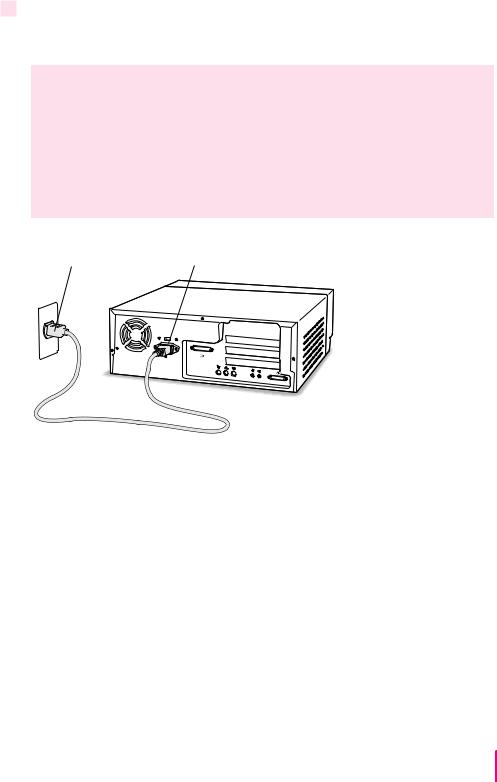
3Plug the other end of the power cord into a three-hole grounded outlet or power strip.
Choose a power outlet to which you have easy access.
WARNING This equipment is intended to be electrically grounded. Your Macintosh is equipped with a three-wire grounding plug—a plug that has a third (grounding) pin. This plug will fit only a grounded AC outlet. This is a safety feature. If you are unable to insert the plug into the outlet, contact a licensed electrician to replace the outlet with a properly grounded outlet. Do not defeat the purpose of the grounding plug!
Power cord plug Power cord socket
IMPORTANT Be sure that at least one end of the power cord is within easy reach so that you can unplug the computer when you need to.
If the computer starts up: If you hear a tone, the computer has started up and you need to turn it off before proceeding. Press the power button located on the front of the computer to turn it off. (Refer to Chapter 3, “Connecting Equipment and Expanding Your Computer,” for an illustration showing the location of the power button on the front of the computer.)
Getting Started |
7 |

Connecting a monitor
You can connect many types of monitors to your Macintosh. To connect a monitor from a manufacturer other than Apple, refer to the instructions that came with it.
WARNING Setting the correct voltage for your computer does not set the voltage for your monitor. To protect your monitor, be sure to use the appropriate adapter or voltage converter, if one is necessary.
Connecting the monitor power cord
Monitors have two cords to connect—a power cord and a monitor cable.
To connect the monitor power cord, follow these steps:
1Place the monitor where you will be using it.
Keep these considerations in mind:
m The case of the computer is sturdy enough for you to place on top of it any monitor that is 17 inches or smaller.
m Allow at least 3 inches for air circulation around the sides of the computer and monitor.
m Make sure that the top of the screen is slightly below eye level when you’re sitting at the keyboard.
m Position the monitor to minimize glare and reflections on the screen from overhead lights and windows.
m Consult “Arranging Your Office” in Appendix A for suggestions on positioning your computer equipment.
8 Chapter 1
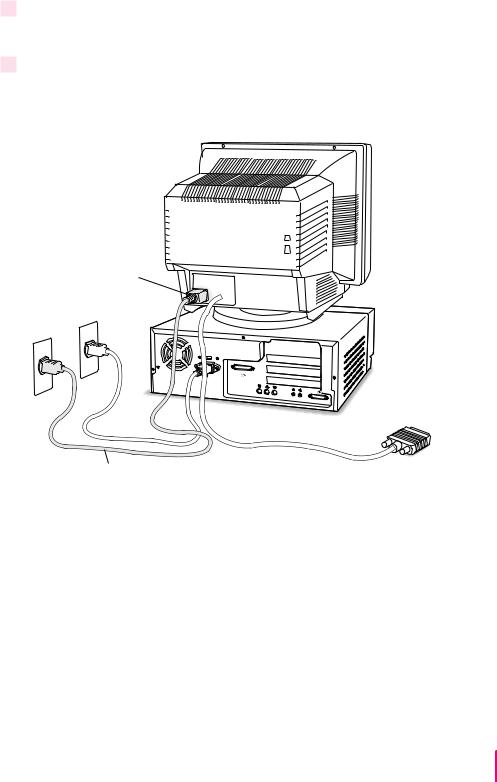
2Connect the monitor power cord to the monitor.
On some monitors, the cord is already attached.
3Plug in the monitor power cord.
Be sure to plug the power cord into a three-hole grounded outlet or power strip.
Monitor power socket
Monitor power cord
Getting Started |
9 |
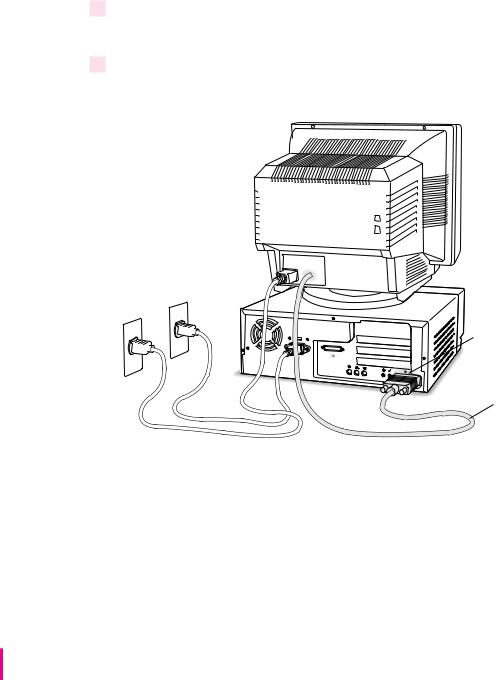
Connecting the monitor cable
After you plug in the monitor power cord, you connect the monitor cable to the computer’s monitor port.
To connect the monitor cable, follow these steps:
1Attach the monitor cable to the monitor.
On some monitors, the cable is already attached (as shown below).
2Attach the monitor cable to the monitor port on the back panel of the computer.
The monitor port is marked with the ™ icon (symbol).
™ Monitor port
Monitor cable
10 Chapter 1
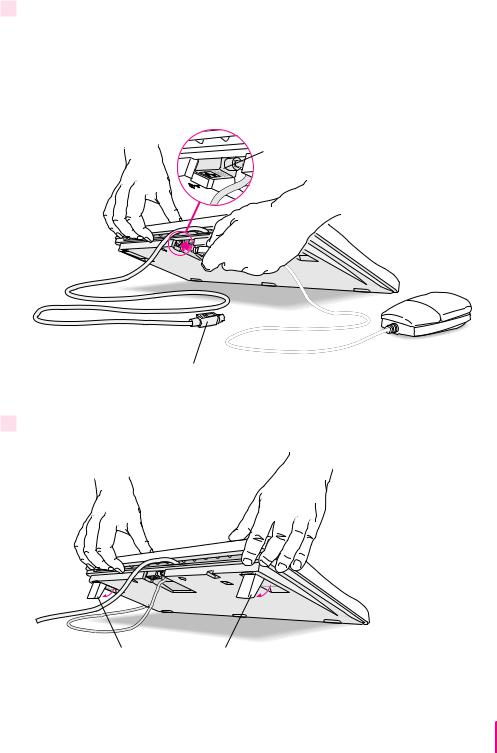
Connecting the mouse and keyboard
1Plug the mouse cable into the recessed port on the back of the keyboard.
The plug and the port are marked with the V icon. The positions of the port and icon on your keyboard may be different from those pictured.
By the way: A port marked with the V icon is called an Apple Desktop Bus (ADB) port.
Plug the mouse cable into the recessed port on the keyboard. The flat part of the plug should be pointing down, as shown here.
This cable plugs into the Apple Desktop Bus (ADB) port, marked with the V icon, on the back of the computer.
2 If you want to adjust the keyboard angle, lower the feet of the keyboard.
To adjust the keyboard angle, lower the feet until they snap into position.
Getting Started |
11 |
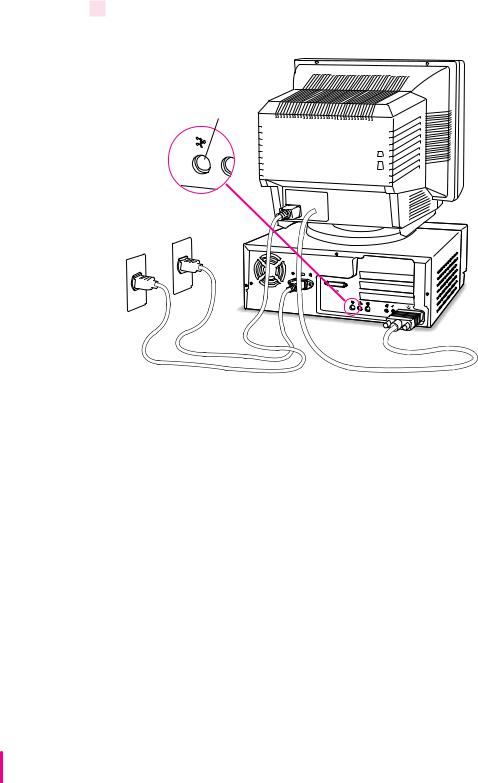
3Plug the keyboard cable into the port marked with the Vicon on the back of the computer.
VADB port
Some monitors have a port to which you can connect the keyboard or mouse. See the information that came with your monitor.
Connecting other equipment
If you are new to the Macintosh, it’s a good idea to get some experience using your computer before you connect other equipment, such as a printer or scanner. To learn basic Macintosh skills, continue with the instructions in this chapter.
When you’re ready to connect other equipment to your Macintosh, see the instructions in Chapter 3.
12 Chapter 1
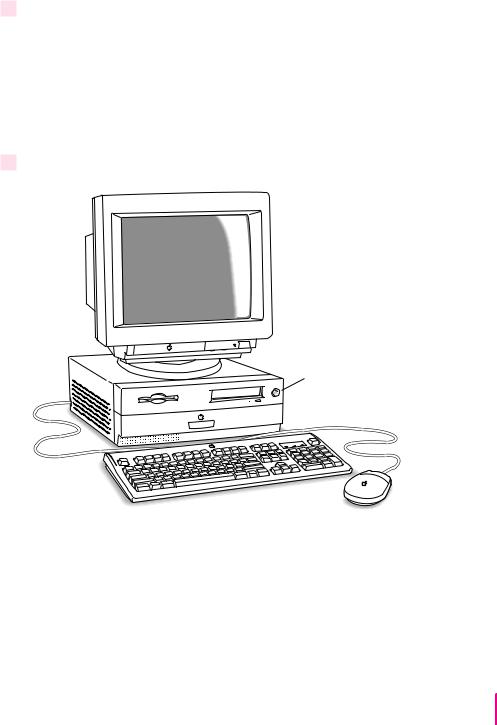
Turning the computer on for the first time
To turn the computer on for the first time, follow these steps:
1Turn on the monitor.
See the information that came with your monitor for the location of the power switch. On newer Apple monitors, the power switch is located on the front of the unit.
Note: If you have extra dynamic random-access memory (DRAM) installed in your computer, it can take several seconds for larger monitors to turn on. (The screen remains black.)
2Turn on your computer by pressing the power button on the front of the unit.
IPower button
You hear a tone from your computer as it starts up.
Note: You only need to use the power button on the front of your computer to turn it on for the very first time; from now on, you can press the Power key on the keyboard to turn on the computer. Refer to “Turning the Computer On” later in this chapter for information about using the Power key on the keyboard to start up your computer.
Getting Started |
13 |
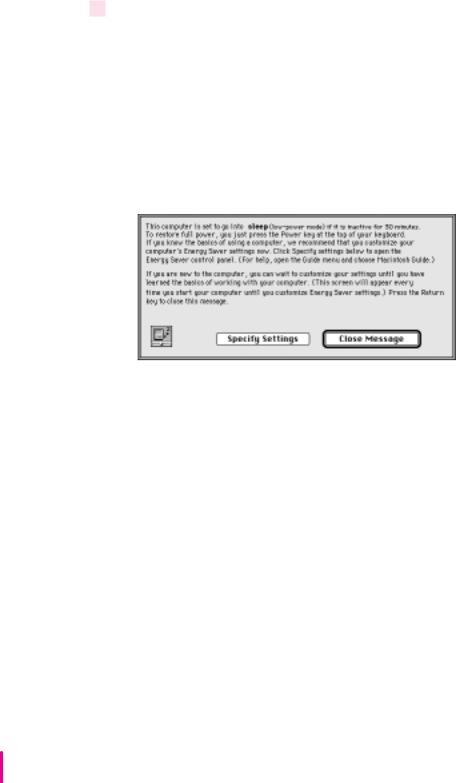
3Check to see what’s on your screen.
You see a sequence of messages describing what is happening, followed by the Energy Saver dialog box.
m If you see a blinking question mark, see “Solutions to Common Problems” in Chapter 6.
m If you see anything else on your screen, or if you see nothing at all, see the section “Problems Starting Up?” next in this chapter.
m If you are a beginning Macintosh user, press the Return key on your keyboard when the Energy Saver dialog box appears.
mIf you’re an experienced Macintosh user, you may want to set your energysaving options now. For more information, refer to “Saving Energy With
the Energy Saver Control Panel,” later in this chapter, and to the “Saving Energy” topic area of Macintosh Guide, available in the Guide (h) menu.
14 Chapter 1

mIf, when you press Return, you see the Macintosh desktop (shown here), your system software is already set up correctly.
Skip now to the section, “What’s Next?”
Hard disk icon
Macintosh desktop
Note: To save energy, your computer is automatically set to put itself to sleep if you haven’t used it for 30 minutes or more (the computer goes into powersaving mode and the screen turns black). If this happens while you’re setting the computer up, simply press the Power key or any key on the keyboard but Caps Lock to “wake up” the computer (it may take a few seconds). See “Saving Energy With the Energy Saver Control Panel,” later in this chapter for more information on setting power-saving options.
Getting Started |
15 |

Problems starting up?
If the screen is dark, check these items to see if you can identify the problem:
mIs the computer turned on? The power-on light on the front of the computer should be on. If it isn’t, press the power button on the front of the computer.
mIs the power cord connected to the computer, and is the cord plugged into a power source?
mIf the computer is plugged into a power strip, is the power strip turned on?
mAre the keyboard and mouse cables connected correctly? (Don’t disconnect the keyboard or mouse cable while the computer is on. You could damage your equipment.)
mIs the monitor power cord plugged in?
mIs the monitor cable attached firmly to both the monitor and computer?
mIs the monitor turned on? (Check the power-on light on the front of the monitor.)
mIs the brightness and contrast control on the monitor adjusted correctly? (On most monitors, the control is marked with the ¸ icon.)
mIf you have an external hard disk attached to your computer, is that hard disk turned on? Was it turned on before you turned on the computer? If you’re not sure, turn everything off. Then turn on the external hard disk before you turn on the computer.
If you see a blinking question mark on the screen, you probably need to read “Solutions to Common Problems” in Chapter 6.
16 Chapter 1

What’s next?
You’ve finished setting up your computer. Continue with one of the following steps:
mIf you are new to the Macintosh, turn to the next section, “Learning the Basics.” When you’ve learned the basic Macintosh skills, turn to the
section “Saving Energy With the Energy Saver Control Panel” to learn how to set energy-saving options for your computer.
mIf you are an experienced Macintosh user, turn to the section “Saving Energy with the Energy Saver Control Panel,” later in this chapter, to learn how to set energy-saving options for your computer. Then turn to Chapter 2, “Getting Help,” to learn about Macintosh Guide, your main source of information when you’re working with the Macintosh.
mIf you want to connect additional equipment, such as a microphone, to your computer, see Chapter 3, “Connecting Equipment and Expanding Your Computer,” for instructions.
mIf you want to install application software on your computer, see Chapter 4, “Installing and Using Application Programs.” You need this information to set up any applications specifically designed for Power Macintosh computers.
IMPORTANT If you need to turn off your computer at any point, please see “Turning the Computer Off” later in this chapter. It is very important to use the correct procedure for shutting down your Macintosh before turning it off.
Getting Started |
17 |
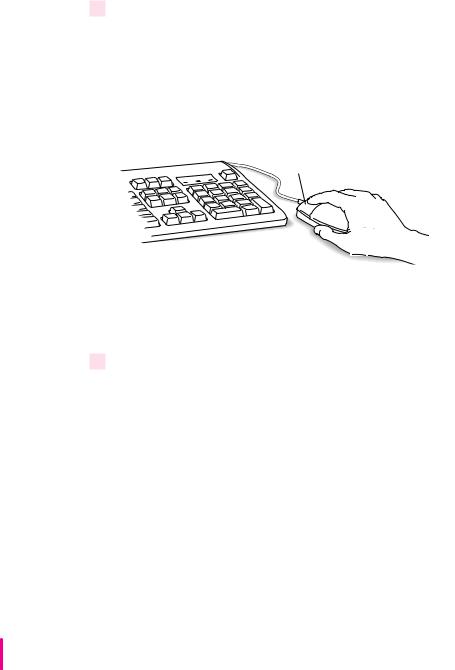
Learning the basics
If you are new to the Macintosh, you should begin by looking at the easy-to-use program called the Macintosh Tutorial. The tutorial teaches you the basic skills you need to use your computer. To start the tutorial, follow these steps:
1Slide your mouse along your mouse pad or desk.
Hold the mouse as shown, with the cable pointing away from you. Rest the heel of your palm on the desk and grasp the sides of the mouse between your thumb and fingers. Use your wrist and fingers to slide the mouse around with
the index finger resting on the mouse button. Don’t press the mouse button (under your index finger). Notice that the arrow (8) on the screen moves in the same direction that you move the mouse.
Mouse button
If the arrow doesn’t move, make sure that the cables connecting the mouse and keyboard are secure and that your mouse is positioned as shown in the illustration.
2Move the tip of the arrow (8) to the question mark (h) in the upper-right portion of the screen.
If you run out of room on your mouse pad or desk while moving the mouse, pick up the mouse and place it where there’s more room. (The arrow on the screen moves only when the mouse is in contact with the mouse pad or desk.)
18 Chapter 1
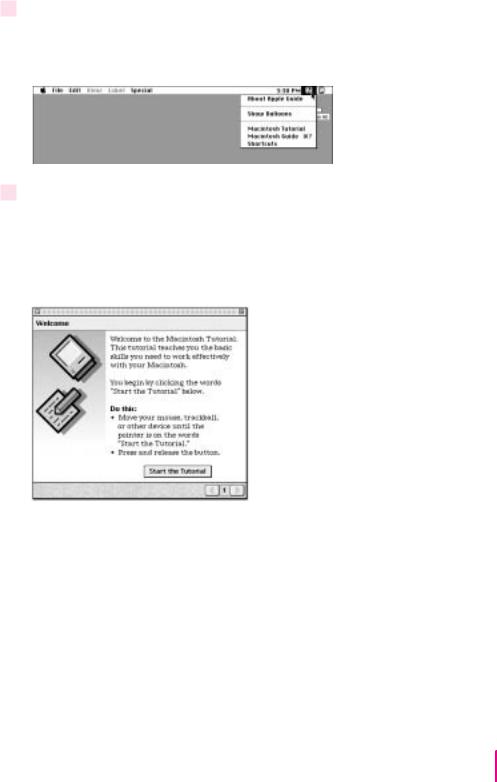
3With the tip of the arrow on the question mark, press and hold down the mouse button.
A list of choices (called a menu) appears. This is the Guide (h) menu, which is the place to go when you have a question about how to use your computer.
4While holding down the mouse button, move the arrow until the words “Macintosh Tutorial” are highlighted, then release the mouse button.
A window appears welcoming you to the tutorial. You can set this book aside for now and follow the instructions on the screen. When you have completed the tutorial, return to this book.
Getting Started |
19 |
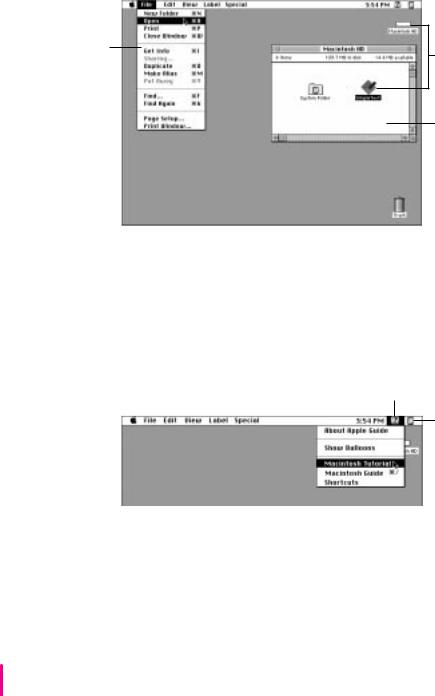
Reviewing the basics
Look at the following illustrations to review the elements you use on your screen to work with your computer.
Menu
Icons
Window
Menus
The strip across the top of the screen is called the menu bar. The symbols and words in it represent menus of commands. To open a menu, place the pointer on the symbol or word for the menu and press the mouse button.
Guide menu
To find an answer to a question, look in the Guide (h) menu.
Application menu
You can have several application programs open at once. To see which program is active or to switch from one program to another, use this menu (called the Application menu).
20 Chapter 1
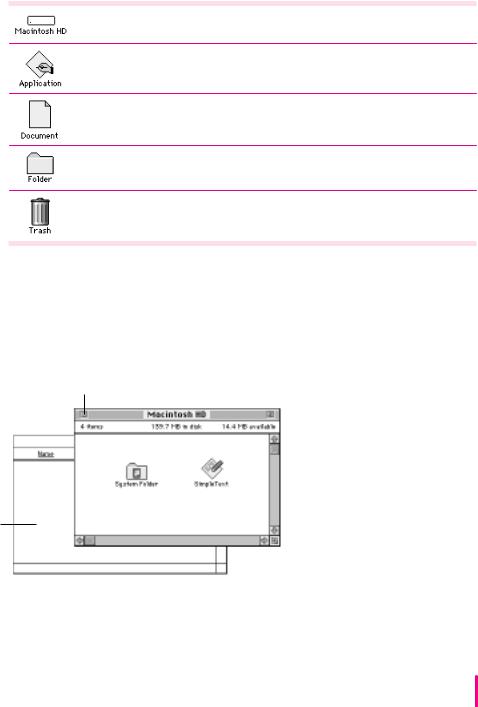
Icons
Icons are small pictures that represent disks, programs, documents, and folders. You can double-click any icon to open it and see what it contains.
This icon represents your computer’s internal hard disk.
Icons like this one represent application programs, which you use to create documents and do other work.
Icons like this one represent documents, which you can create and edit.
Icons like this represent folders. A folder contains other icons.
To throw away an item you no longer want, drag it to the Trash icon and choose Empty Trash from the Special menu.
To bring a partially covered window to the front, click anywhere in it.
Windows
Windows are boxes that display text, graphics, or icons. To change the shape or position of a window, or to close the window, use the elements shown here.
Close box |
Title bar |
||
To close a window, |
To move a window, drag it by the middle of the title |
||
click the close box. |
bar (anywhere in the bar except the small boxes). |
||
|
|
|
Scroll arrow |
|
|
|
|
|
|
|
To bring hidden portions |
|
|
|
of a window’s contents |
|
|
|
into view, click one of the |
|
|
|
four scroll arrows. |
|
|
|
Size box |
|
|
|
|
|
|
|
To change the shape or size of |
|
|
|
a window, drag the size box. |
Getting Started |
21 |

Saving energy with the Energy Saver control panel
When you save energy, you save natural resources and reduce pollution. Your Power Macintosh contains features that automatically save energy. You can increase the savings by using the Energy Saver control panel to shut down your computer if you won’t be using it for a while—for example, overnight or over the weekend.
The Energy Saver dialog box (shown in step 3 of “Turning the Computer On for the First Time” earlier in this chapter) appears every time you start up your computer until you open the Energy Saver control panel. Once you open the control panel, you can keep the preset options shown there or set your own energy-saving options. If you do not want to set your energy-saving options when the Energy Saver dialog box is displayed, you can click Close Message or press Return (the Energy Saver dialog box continues to appear when you start up your computer).
Setting energy-saving options
You can get to the Energy Saver control panel by clicking Specify Settings in the Energy Saver dialog box that appears when you start up your computer or by choosing Control Panels in the Apple (K) menu.
The Energy Saver control panel displays options you can accept or change. For more information on using the Energy Saver control panel, see the “Saving Energy” topic area of Macintosh Guide, available in the
Guide (h) menu.
22 Chapter 1
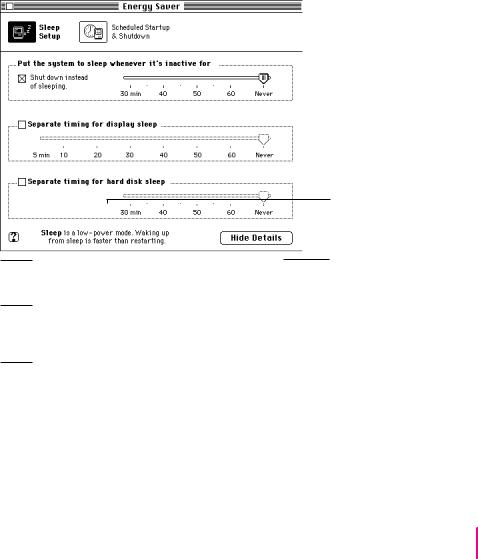
Putting your computer to sleep
Your Power Macintosh is preset to put itself to sleep after 30 minutes of inactivity. When your computer goes to sleep, the screen enters a low-power mode in which it dims and the hard disk stops spinning but remains ready to start back up quickly. (To prevent your computer from overheating, the fan continues to spin.) If the computer goes to sleep while you have unsaved information on screen, you do not lose any of the information.
To put your computer to sleep right away, choose the Sleep command from the Special menu, or press the Power key on the keyboard to bring up the Shutdown dialog box pictured below.
Click here to put your computer to sleep now.
To set sleep options, use the Energy Saver control panel, available under Control Panels in the Apple (K) menu.
Click here to have the computer shut down instead of going to sleep.
Click here to set separate timing for monitor sleep.
Click here to set separate timing for hard disk sleep.
Click here to set up automatic startup and shutdown.
Drag the slider to set the time to wait before sleeping.
Getting Started |
23 |
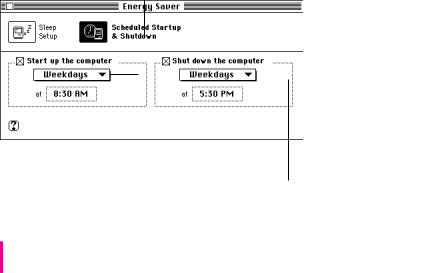
Waking your computer from sleep
To wake the computer from sleep, press any key on the keyboard except Caps Lock. (It may take a moment or two for the computer to awaken.) The documents and application programs you had open when the computer went to sleep are still open and unsaved changes are preserved.
Accessing a sleeping computer over a network
If your computer is being used as a server, other users can still access it over a network while it is asleep if you set server options that prevent the hard disk from going to sleep. (You can set server options using the Preferences menu when the Energy Saver control panel is displayed.) The network connection does not have to be established before the computer goes to sleep. However, if you’ve chosen to have your computer shut itself down rather than go to sleep, other users will not be able to access it over a network after the computer shuts itself down.
Scheduling automatic startup and shutdown
You can set your computer to start up and shut down at specified times using the Energy Saver control panel. For information on using the Energy Saver control panel, see the “Saving Energy” topic area of Macintosh Guide, available in the Guide (h) menu. If there’s an unsaved document open on your desktop when the scheduled shutdown time occurs, it is saved automatically for you in a folder on your startup disk. The folder is named with the date and time of the shutdown.
Click here to set up sleep options.
Click here to set your computer to start up automatically. (Use the pull-down menu and text box to choose frequency and time.)
Click here to set your computer to shut down automatically.
24 Chapter 1

Inserting a CD-ROM disc or other CD
Your internal CD-ROM drive works with CD-ROM discs, standard audio compact discs (CDs), and single-session or multisession Photo CDs. Follow these instructions to insert a CD-ROM disc (or other CD) into your CD-ROM drive. Then follow the instructions provided with your disc, as well as the instructions in this manual.
1Start up your Macintosh computer, if it’s not already on.
2Press the Open/Close button to open the tray of the CD-ROM drive.
Open/Close button
The tray opens.
3Place a disc in the tray with the disc label facing up.
Make sure the disc is lying flat and centered in the tray. If you are using a small (8 cm) disc, make sure it is centered within the inside ring on the tray.
Place the CD disc, label side up, in the CD-ROM
drive tray.
|
Getting Started |
25 |
|

4 Close the tray by gently pushing it in or by pressing the Open/Close button.
In a few moments, an icon for the disc appears on your screen.
For more information about working with a CD-ROM disc or other CD, see the “CD-ROM Discs” topic area of Macintosh Guide, available in the Guide (h) menu. For instructions on using Macintosh Guide, see Chapter 2 of this manual.
CD-ROM disc vibration
Your CD-ROM drive reads CD-ROM discs very quickly, but because of the high rotation speed of the drive, some CD-ROM discs can wobble in it and cause the computer to vibrate. This vibration affects very few CD-ROM discs and does not damage your computer or the CD-ROM disc itself, but you should be aware of the vibration in case it occurs.
What causes the vibration? Some CD-ROM disc labels have artwork on them that can cause the CD-ROM disc’s weight to be slightly off-center. For example, the label (or “paint”) on the CD-ROM disc may be noticeably thicker on one side than the other. A slightly off-center CD-ROM disc spinning in the drive can wobble and cause your computer to vibrate.
26 Chapter 1

Ejecting a CD-ROM disc or other CD
You eject a CD-ROM disc or other CD with the Put Away command in the File menu.
1Close any files and quit any programs you've opened on the CD-ROM disc.
You cannot eject a disc that contains files or applications that are in use by your computer.
2Click the disc icon to select it.
3Choose Put Away from the File menu.
The tray opens.
Note: You can also eject a CD-ROM disc by dragging its icon to the Trash.
4Remove the disc. Then either gently push the tray in or press the Open/Close button to close the tray.
Turning the computer off
You can turn your computer off either with the Power key or by using the Shut Down command.
Using the Power key
To turn the computer off using the Power key (marked with a triangle) on the keyboard, follow these instructions:
1If the computer is in sleep mode, press any key on the keyboard except Caps Lock to wake it.
For information on the sleep feature of your Macintosh, see “Saving Energy With the Energy Saver Control Panel” earlier in this chapter.
Getting Started |
27 |
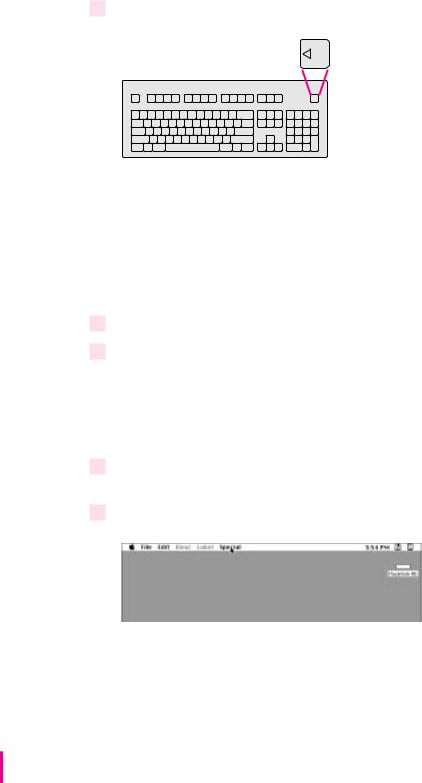
2 Press and hold down the Power key on the keyboard for about 2 seconds.
the screen:
3Press the Return key on the keyboard, or click the Shut Down button in the dialog box.
4Turn off the monitor.
Using the Shut Down command
You can also turn your computer off by using the Shut Down command in the Special menu. Follow these steps:
1If the computer is in sleep mode, press the Power key or any key on the keyboard except Caps Lock to wake it.
2Move the tip of the arrow to the word “Special” at the top center of the screen.
28 Chapter 1

If the word “Special” does not appear in the menu bar at the top of the screen, you’re not working in the Finder, the application you need to be in when you shut down your computer. Choose Finder from the Application menu (at the far right of the menu bar). Then try step 2 again.
3With the tip of the arrow on the word “Special,” press and hold down the mouse button.
4While holding down the mouse button, drag the arrow until the words “Shut Down” are highlighted, then release the button.
5Turn off the monitor.
To turn the computer on again, just press the Power key on the keyboard.
If you can’t shut down your computer
If a problem with the computer prevents you from using the Power key on the keyboard or choosing Shut Down—for example, if the computer “freezes” so that the pointer does not respond to the mouse—you can turn off the computer by pressing the power button on the front of the computer. Use this method only if you cannot choose Shut Down or Restart after following the instructions in “Using the Power Key” or “Using the Shut Down Command.”
IMPORTANT You could lose unsaved work if you use the power button on the front of the computer to turn off your computer. Only use the power button when there is a problem that prevents the computer from being turned off with the Power key on the keyboard or the Shut Down command. To make sure your work is saved, use the Power key on the keyboard or the Shut Down command.
Getting Started |
29 |
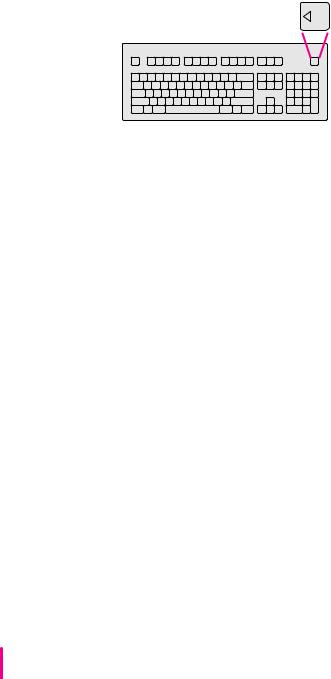
Turning the computer on
To turn the computer on after you’ve shut it down with either the menu command or the keyboard, press the Power key on the keyboard. The Power key is marked with a triangle symbol.
Note: You also have to turn on the monitor separately each time you turn on the computer.
30 Chapter 1
